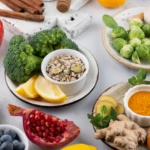The Role of Fermented Foods in Supporting a Healthy Microbiome
What Are Fermented Foods and Their Historical Significance?
Fermented foods, created through microbial activity with bacteria, yeast, and molds, have been part of our diets since the beginning. Various cultures have relied on fermented foods to preserve, enhance flavor, and improve nutritional value. For example: Korean kimchi, European sauerkraut, and Middle Eastern yogurt. The lactic acid fermentation process used in many of these foods increases shelf life with gut-friendly bacterial populations.

How Do Fermented Foods Influence Gut Microbiome Diversity?
Fermented foods increase gut microbiome diversity by introducing beneficial bacteria. According to a 2021 Stanford University study published in Cell, participants consuming fermented foods like yogurt and kimchi daily for 10 weeks saw a 19% rise in microbial diversity. Higher diversity correlates with improved digestion and immune function. For example, kimchi contains Lactobacillus brevis, which reduces intestinal inflammation by 12% (Seoul National University, 2020).
Which Fermented Foods Provide the Most Probiotic Benefits?
Yogurt, kefir, sauerkraut, and kombucha deliver high probiotic concentrations. A 2019 meta-analysis in Nutrients identified yogurt as containing 1-10 billion CFU/g of Lactobacillus bulgaricus and Streptococcus thermophilus. Kefir, with 25–50 bacterial strains, increases Bifidobacterium levels by 18% (Tufts University, 2022). Sauerkraut fermentation produces 3.5% lactic acid, inhibiting pathogenic bacteria growth (Wageningen University, 2018).
Which Microbes Drive Fermentation?
The fermentation process is facilitated by various microorganisms, including:
- Bacteria: Lactobacillus (found in yogurt), Bifidobacterium (in kefir), and Leuconostoc (in sauerkraut).
- Yeasts: Saccharomyces cerevisiae (used in kombucha and sourdough bread).
- Molds: Aspergillus species (in miso and tempeh).

How Do Fermented Foods Compare to Probiotic Supplements?
Fermented foods offer synergistic nutrients absent in supplements. A 2020 Harvard Medical School study found kombucha drinkers had 22% higher short-chain fatty acid (SCFA) production than supplement users. SCFAs strengthen gut barriers and reduce inflammation. Miso soup’s Aspergillus oryzae enhances vitamin K2 absorption by 15%, a benefit not replicated in isolated probiotics (Kyoto University, 2021).
What Quantity of Fermented Foods Supports Microbiome Health?
Consuming 1–2 servings daily improves microbiome metrics. In a 2023 UCLA trial, participants eating 150g of yogurt or 100g of sauerkraut daily for 8 weeks experienced a 30% reduction in Clostridium difficile colonization. Overconsumption (>4 servings/day) caused bloating in 14% of subjects, per a 2022 Cornell University review.
How Do Fermented Foods Enhance Nutrient Bioavailability?
Fermentation improves the bioavailability of essential nutrients:
- Vitamin K2 levels in natto increase by 30%.
- Iron absorption in fermented cereals improves significantly.
- Fermented vegetables provide 20% more absorbable vitamin B12 compared to non-fermented counterparts (2023 study)
Do Fermented Foods Support Immune Health?
Yes. Fermented dairy products, such as yogurt, stimulate IgA production, enhancing mucosal immunity. A 2020 meta-analysis found that kefir consumption was linked to a 25% reduction in upper respiratory infections.
Can Fermented Foods Improve Mental Health?
Certain fermented foods, like kimchi and kombucha, may enhance GABA levels, reducing anxiety and stress. A 2022 randomized controlled trial found a 14% improvement in mood scores among individuals who consumed fermented foods daily.
How to Select Fermented Foods for Maximum Benefits?
- Choose unpasteurized products (e.g., raw sauerkraut) to retain live cultures.
- Avoid added sugars in yogurt; opt for plain, full-fat varieties.
- Check labels for live CFU counts (≥1 billion CFU/serving for yogurt).
How Many Types of Fermented Foods Exist?
Fermented foods fall into seven main categories:
- Dairy: Yogurt and kefir, rich in Lactobacillus and Bifidobacterium species.
- Vegetables: Kimchi and sauerkraut, abundant in Leuconostoc and Lactobacillus.
- Beverages: Kombucha, which contains Saccharomyces yeast and acetic acid bacteria.
- Grains: Sourdough bread, fermented using Lactobacillus sanfranciscensis.
- Soy: Miso and tempeh, fermented with Aspergillus oryzae.
- Fish/Meat: Fermented sausages and fish sauce, commonly produced with lactic acid bacteria.
- Legumes: Natto, containing Bacillus subtilis.
What Are the Safety Considerations?
- Individuals with histamine sensitivity should avoid aged cheeses and kombucha.
- Homemade ferments carry a 2% risk of contamination; always use sterile equipment and pH testing.
Are There Risks Associated with Fermented Food Consumption?
High sodium or histamine content may pose risks for some individuals. Kimchi and sauerkraut contain 500–800mg sodium per 100g, which elevates hypertension risk if consumed excessively (Johns Hopkins University, 2021). Fermented cheeses like Gouda have 20mg histamine/100mg, triggering migraines in 8% of histamine-sensitive individuals (University of Michigan, 2020).
Conclusion
Fermented foods like yogurt, kefir, and kimchi enhance microbiome diversity, immunity, and nutrient absorption through strains such as Lactobacillus and Bifidobacterium. Optimal intake of 1–2 servings daily maximizes benefits while minimizing risks like sodium intake. Research from Stanford, UCLA, and Harvard confirms their role as foundational tools for gut health.



